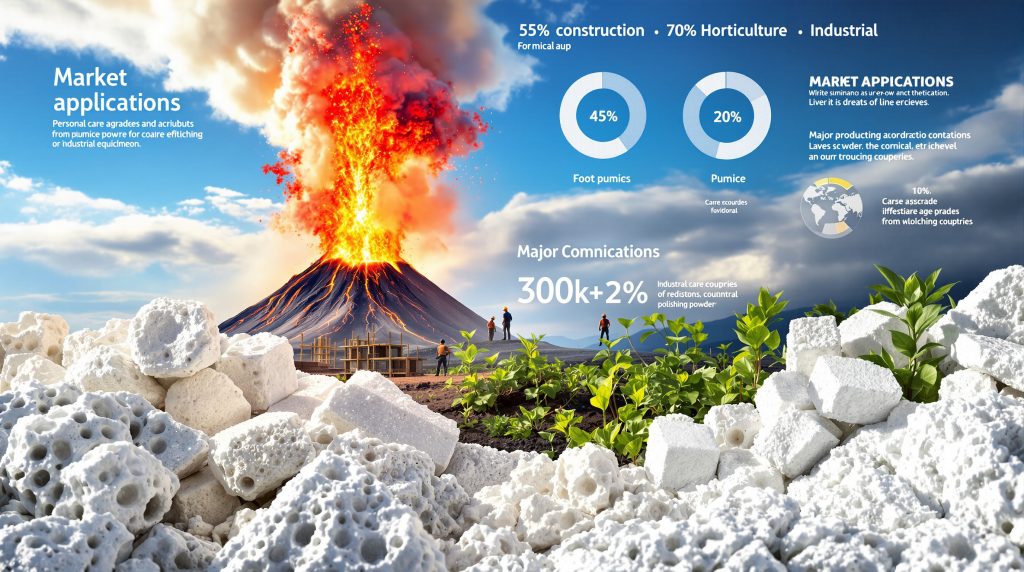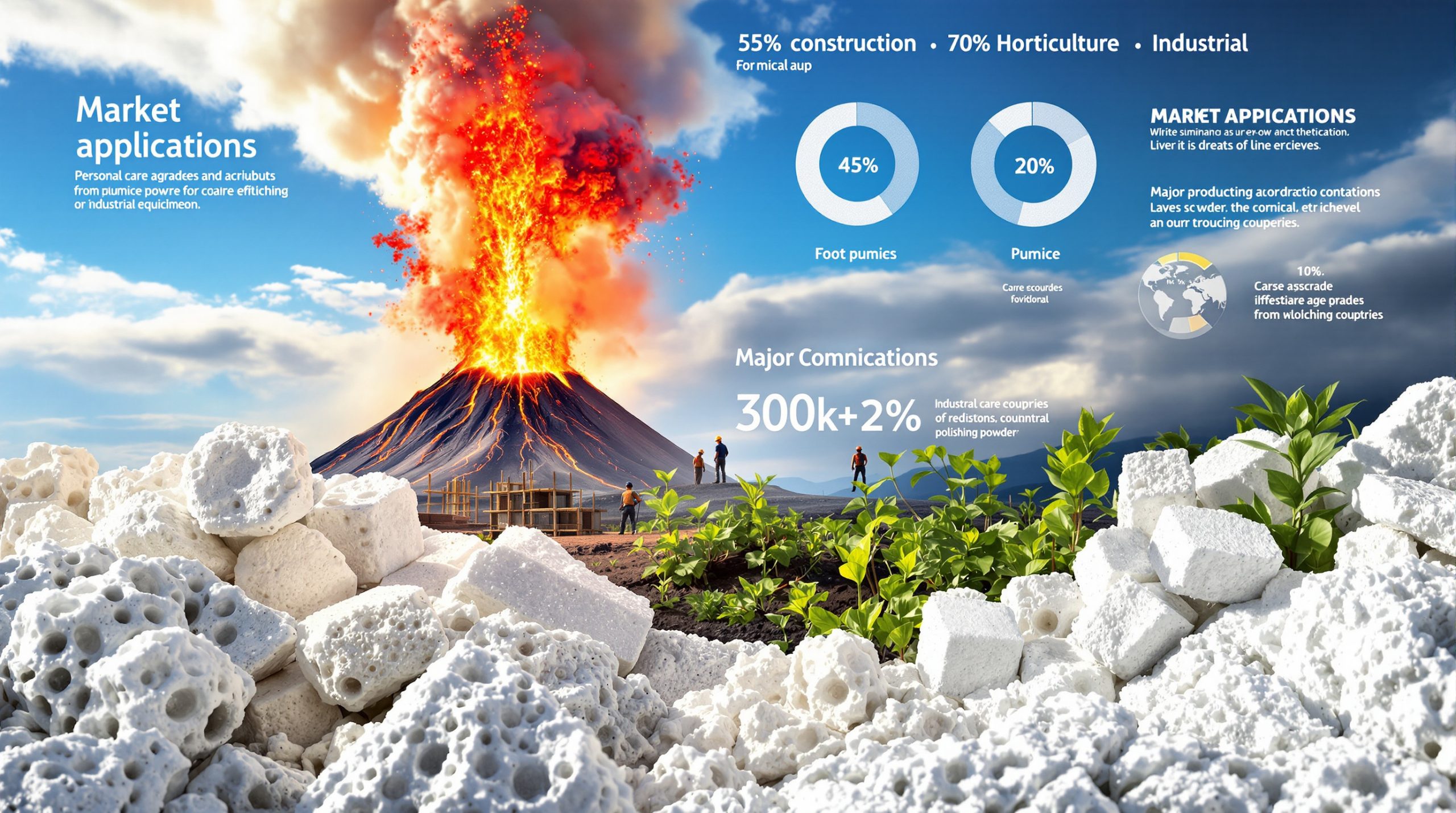Understanding Pumice: The Remarkable Volcanic Glass
Pummus uses and applications span diverse industries worldwide, making this extraordinary volcanic glass one of nature's most versatile materials. This fascinating volcanic glass emerges when gas-saturated magma undergoes rapid cooling during explosive volcanic eruptions, resulting in a material that defies conventional expectations of what rock should look and feel like.
The formation process begins deep within the Earth's crust, where molten rock accumulates dissolved gases including water vapor, carbon dioxide, and sulfur compounds. As this gas-rich magma ascends through volcanic conduits, decreasing pressure causes these dissolved gases to expand dramatically, creating a foam-like structure within the molten material. When this frothy magma reaches the surface during violent eruptions, it encounters dramatically lower atmospheric pressure and cooler temperatures, causing instantaneous solidification that traps countless gas bubbles within a glassy matrix.
This unique formation mechanism produces a rock with extraordinary characteristics that make it instantly recognizable in the field. Furthermore, geological logging codes help professionals accurately document and classify these distinctive volcanic materials in exploration programmes.
Pumice typically exhibits a light coloration ranging from white and pale gray to cream and light brown, occasionally displaying subtle pink or yellowish tints depending on the mineral composition of the source magma. The most striking feature remains its incredibly porous structure, where vesicles can comprise between 50 to 90 percent of the total rock volume.
Physical Properties That Set Pumice Apart
The exceptional porosity of pumice creates a material with remarkable physical characteristics that distinguish it from all other volcanic rocks. With a specific gravity typically ranging from 0.25 to 0.89 grams per cubic centimetre, pumice often floats on water, making it one of the few rocks capable of this feat.
Key Physical Characteristics Include:
• Density: Significantly lower than water due to high vesicularity
• Texture: Rough, abrasive surface with a frothy, sponge-like appearance
• Hardness: Approximately 6 on the Mohs scale, despite its fragile structure
• Composition: Primarily volcanic glass with 60-75% silica content
• Colour Range: Predominantly light tones from white to light brown
The glassy nature of pumice results from the rapid cooling that prevents crystal formation, creating an amorphous structure that produces sharp, sparkly surfaces when freshly broken. This vitreous quality, combined with its abrasive texture, makes pumice particularly valuable for applications requiring controlled material removal without excessive damage.
Construction and Building Material Applications
Modern construction industries increasingly recognise pummus uses and applications as valuable lightweight aggregate that can significantly reduce structural weight while maintaining essential strength characteristics. When incorporated into concrete mixtures, pumice can decrease overall weight by up to 50 percent compared to conventional aggregates, translating to substantial cost savings in foundation requirements and structural engineering.
Lightweight Concrete Systems
The integration of pumice into concrete systems creates materials with superior insulating properties while maintaining structural integrity. In addition, sustainable mining practices ensure responsible extraction of these valuable volcanic materials.
These lightweight concrete applications prove particularly beneficial in:
• High-rise construction where weight reduction directly impacts foundation costs
• Precast panel manufacturing combining structural strength with energy efficiency
• Insulating concrete blocks offering enhanced thermal performance
• Speciality mortars requiring reduced density without compromising adhesion
Pozzolanic Properties and Durability Enhancement
Pumice functions as a natural pozzolan, chemically reacting with calcium hydroxide produced during cement hydration to form additional cementitious compounds. This reaction enhances long-term concrete durability and strength development, demonstrated by ancient Roman structures that incorporated volcanic materials and remain intact after two millennia.
| Concrete Property | Conventional Mix | Pumice-Enhanced Mix |
|---|---|---|
| Density | 2,300-2,400 kg/m³ | 1,200-1,600 kg/m³ |
| Thermal Conductivity | 1.4-1.8 W/mK | 0.3-0.8 W/mK |
| Compressive Strength | 25-40 MPa | 15-35 MPa |
| Weight Reduction | Baseline | 30-50% lighter |
Horticultural and Agricultural Enhancement
The unique structure of pumice creates ideal conditions for plant growth by simultaneously providing excellent drainage while retaining necessary moisture. This dual functionality makes it invaluable for specialised growing applications where conventional soil amendments prove inadequate.
Soil Conditioning Benefits
Pumice improves soil structure through several mechanisms:
• Enhanced aeration: Prevents soil compaction while promoting root oxygen access
• Moisture regulation: Retains water in pores while preventing waterlogged conditions
• Permanent structure: Resists decomposition, providing long-term soil improvement
• pH neutrality: Compatible with most plant species without chemical adjustment
Specialised Growing Applications
Professional horticulturists increasingly rely on pumice for challenging growing situations:
Succulent and Cactus Cultivation: The excellent drainage properties prevent root rot while providing adequate moisture retention for desert plants adapted to arid conditions.
Orchid Growing Media: Creates the perfect balance of drainage and air circulation essential for epiphytic orchid species that require well-ventilated root zones.
Green Roof Systems: Provides lightweight growing medium that reduces structural load while maintaining plant health in challenging rooftop environments.
Hydroponic Applications: Serves as an inert growing medium that maintains stability while allowing precise nutrient control.
Personal Care and Cosmetic Applications
The naturally abrasive yet relatively gentle texture of pumice makes it an ideal material for personal care applications, particularly in products designed for exfoliation and skin conditioning. Unlike synthetic abrasives, pumice provides controlled material removal without excessive irritation when properly sized and processed.
Traditional and Modern Foot Care
Pumice stones have been utilised for foot care across cultures for centuries, with modern applications maintaining these traditional benefits:
• Callus reduction: Gradual removal of thickened skin without aggressive cutting
• Heel smoothing: Restoration of smooth skin texture through gentle abrasion
• Corn treatment: Safe reduction of pressure-induced skin buildup
• Regular maintenance: Prevention of excessive callus formation through routine use
Cosmetic Product Integration
Contemporary skincare formulations incorporate finely processed pumice in various products:
Body Scrubs and Exfoliants: Provide mechanical exfoliation that removes dead skin cells whilst stimulating circulation and skin renewal.
Facial Cleansing Products: When properly sized, offers gentle facial exfoliation suitable for regular use without causing micro-damage.
Professional Treatments: Utilised in spa and salon treatments for comprehensive skin conditioning and renewal procedures.
Industrial Manufacturing Applications
The controlled abrasiveness and chemical inertness of pumice make it valuable across numerous industrial applications where precise material removal or specific surface textures are required. However, understanding natural capital in mining operations helps ensure responsible resource utilisation.
Metal Finishing and Polishing
Industrial applications capitalise on pumice's consistent abrasive properties:
• Precision polishing: Achieves smooth finishes without excessive material removal
• Surface preparation: Creates optimal surface conditions for subsequent treatments
• Cleaning compounds: Removes stubborn deposits whilst preserving underlying surfaces
• Restoration work: Safely removes corrosion and surface contamination
Manufacturing Process Enhancement
Rubber and Plastics Industry: Functions as a lightweight filler that reduces material costs whilst maintaining physical properties. The addition of pumice can improve dimensional stability and reduce shrinkage during manufacturing processes.
Paint and Coatings: Creates textured finishes and non-slip surfaces whilst serving as a volume extender that reduces raw material costs without compromising performance characteristics.
Cleaning Product Formulation: Provides controlled abrasive action in household and industrial cleaning compounds, offering effective cleaning without surface damage.
Environmental and Filtration Applications
The high surface area and chemical stability of pumice make it excellent for environmental applications, particularly in water treatment and soil remediation projects where both physical filtration and biological activity support are required.
Water Treatment Systems
Pumice serves multiple functions in water treatment:
• Physical filtration: Removes suspended particles through mechanical straining
• Biological substrate: Provides surface area for beneficial bacteria colonisation
• pH buffering: Helps maintain stable water chemistry in treatment systems
• Long-term stability: Resists breakdown and maintains filtration efficiency
Constructed Wetland Applications
Environmental engineers increasingly specify pumice for constructed treatment wetlands due to its combination of porosity, chemical stability, and lightweight characteristics. These systems utilise pumice as both a physical support medium and a habitat for the microorganisms essential to biological water treatment processes.
Global Market Dynamics and Economic Considerations
The worldwide pumice industry reflects regional volcanic geology, with major production centres concentrated in areas of recent or historical volcanic activity. Understanding these supply patterns proves crucial for industries dependent on consistent pumice availability.
Major Production Regions
Turkey: Dominates global production with extensive deposits from the Cappadocia region and other volcanic areas, supplying approximately 40 percent of world demand.
United States: Significant production from Oregon, California, and other western states with active or recent volcanic activity.
Italy: Historical production from Vesuvius, Etna, and other Mediterranean volcanic centres continues to serve European markets.
Greece: Island-based operations, particularly from Santorini and other Aegean volcanic islands.
Market Segmentation and Applications
| Application Sector | Market Share | Growth Trend |
|---|---|---|
| Construction Materials | 45-50% | Moderate growth |
| Horticulture | 25-30% | Strong growth |
| Industrial Abrasives | 15-20% | Stable demand |
| Personal Care | 5-10% | Steady demand |
| Environmental | 5-8% | Emerging growth |
Selection Criteria and Application Best Practices
Successful pumice utilisation requires careful attention to grade selection, particle size distribution, and application-specific requirements. Different end uses demand distinct characteristics that must be matched to available material grades. Consequently, understanding pummus uses and applications becomes crucial for optimal selection.
Grade Classification Systems
Construction Applications:
• Coarse grades (10-50mm): Lightweight aggregate for structural concrete
• Medium grades (2-10mm): General concrete additives and decorative applications
• Fine grades (0.1-2mm): Specialised mortars and surface treatments
Horticultural Applications:
• Standard size (3-8mm): Optimal for most soil amendment applications
• Fine grade (1-3mm): Seed starting and delicate plant applications
• Coarse grade (8-15mm): Drainage layers and large container plantings
Quality Control Considerations
Professional applications require attention to several quality factors:
Purity Requirements: Low dust content and minimal foreign material contamination ensure optimal performance across applications.
Particle Size Consistency: Uniform grading within specified ranges prevents segregation and ensures predictable performance characteristics.
Chemical Stability: Neutral pH and low soluble salt content prevent adverse reactions in sensitive applications.
Emerging Technologies and Future Applications
Research continues into advanced pumice applications that leverage its unique combination of properties for next-generation technologies and sustainable solutions. Furthermore, geological modelling techniques help identify optimal pumice deposits for extraction.
Advanced Construction Technologies
Geopolymer Concrete: Research indicates pumice can enhance the performance of alkali-activated concrete systems, potentially reducing carbon footprint whilst improving durability characteristics.
Thermal Energy Storage: The thermal mass properties of pumice make it a candidate for passive solar heating systems and thermal regulation applications in green building design.
Acoustic Insulation: Studies demonstrate significant sound-dampening capabilities that could revolutionise noise control in urban construction applications.
Environmental Innovation
Emerging environmental applications include advanced biofilter media for wastewater treatment, where the high surface area supports enhanced biological activity whilst the lightweight nature simplifies system design and maintenance requirements.
Geological Significance and Formation Indicators
Beyond its practical applications, pumice serves as a crucial geological indicator of explosive volcanic activity, helping scientists understand volcanic processes and assess future volcanic hazards in affected regions. In addition, volcanogenic ore deposits often associate with similar explosive volcanic environments.
Volcanic History Documentation
Pumice deposits in sedimentary sequences provide:
• Eruption timing: Precise dating of volcanic events through stratigraphic analysis
• Eruption magnitude: Volume estimates based on deposit thickness and distribution
• Wind patterns: Historical atmospheric circulation indicated by deposit distribution
• Volcanic evolution: Changes in magma composition over time
Field Identification Techniques
Visual Characteristics: Light colouration, frothy texture, and obvious vesicularity distinguish pumice from similar volcanic materials like scoria, which appears darker and denser.
Physical Tests: The float test remains the most reliable field identification method, as true pumice maintains buoyancy for extended periods whilst similar materials sink immediately.
Geological Context: Association with explosive volcanic deposits, ash layers, and pyroclastic flow materials confirms volcanic origin and supports positive identification.
What Makes Pumice Environmentally Sustainable?
As industries increasingly focus on environmental responsibility, pummus uses and applications offer a naturally occurring, renewable resource that can replace synthetic materials in many applications. The lightweight properties reduce transportation costs and energy consumption, whilst natural abundance in volcanic regions ensures sustainable supply.
"The future of construction lies in materials that combine performance with environmental responsibility, making pumice an increasingly attractive option for sustainable development," notes leading construction industry research.
Understanding pumice requires appreciation for both its dramatic geological origins and its remarkable versatility in human applications. From its formation in the violent moments of explosive volcanism to its gentle use in personal care products, this extraordinary material demonstrates how nature's most extreme processes can produce resources that enhance daily life across countless applications.
Want to Capitalise on the Next Major Volcanic Mineral Discovery?
Discovery Alert instantly identifies significant ASX mineral discoveries using its proprietary Discovery IQ model, delivering real-time alerts that transform complex geological data into actionable investment opportunities. Explore how historic volcanic-hosted discoveries have delivered exceptional returns and begin your 30-day free trial today to position yourself ahead of the market.




